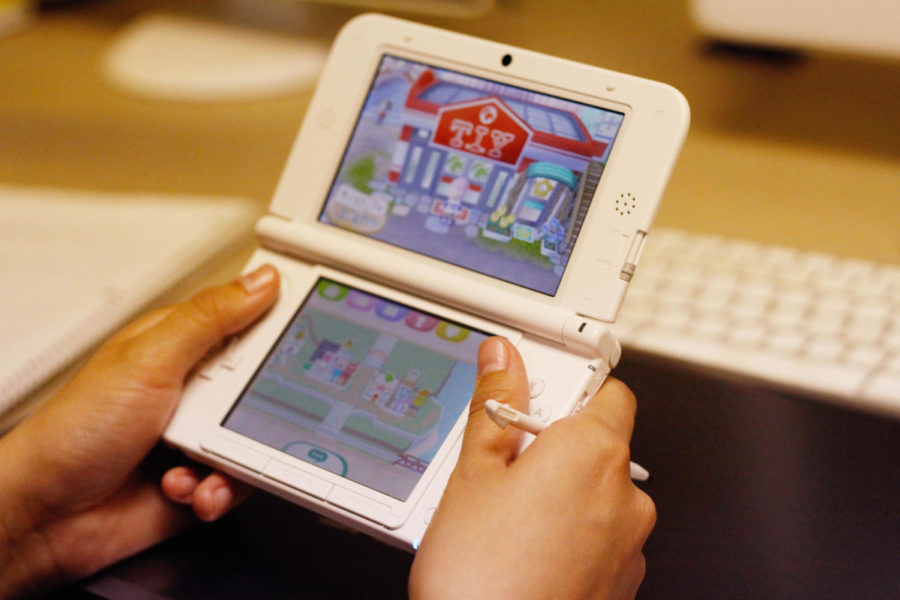Handheld gaming still thrives thanks to Nintendo
Brian Achenbach/Iowa State Daily
Since the debut of the original Game Boy in 1989, Nintendo has held supreme dominion over the handheld console market. Apps for phones and tablets are taking over the market now.
September 19, 2013
Despite the heavy sales and popularity of IOS and Android market phone game, the Nintendo 3DS has dominated in sales against the Xbox 360 and PS3, according to a recent report by NPD Group, a North American market research company.
Nintendo dominated the handheld console market since it debuted the original Game Boy in 1989. For nearly 25 years, Nintendo has held off any challenger who has since entered the handheld arena, outselling competitors whose handhelds boasted better hardware, mainly with Italian plumbers murdering turtle-men, and renegade children battling monsters for large sums of money.
Nintendo has the handheld consoles in a vice, overcoming Sony’s attempts of touting the PSVita as an alternative handheld; but an alternative does indeed exist. Mobile gaming on IOS and Android platforms presents a threat to the future on of dedicated handheld gaming consoles.
“I’d rather emulate old Game Boy games on my phone than a new handheld,” said Luke McDonald, junior in computer engineering. “Phones are just way more accessible. Everyone has a phone; it’s easier to buy a game on the app market and download to your phone than carrying around a handheld console.”
A typical quest in “Monster Hunters 3 Ultimate” on the 3DS can take up 30 minutes to complete depending on the player’s skill level — much longer than most CyRide commutes on campus.
Imagine playing the 3DS version of “Resident Evil: Revelations” with the Game Pad Plus attachment on a packed, elbow-to-elbow bus ride. It is more convenient for the average person to load up a game. The free side-scroller “Jetpack Joyride” has claimed 50 million downloads on Google Play and can easily entertain a commuter during a five-minute session before a lecture begins.
“I only play games on my down time, so there’s no reason for me play games everywhere I go,” said Ian Knight, student in computer engineering.
The price of handhelds consoles and their games has been an intimidating factor shying people away from handheld consoles.
Most 3DS games can empty wallets with titles launching between $30 to $40, while an app game can be found on the Google Play Store for the price of hitting “download and install.”
“I can see the appeal of mobile games for smart phones and iPads, though,” Knight said. “It makes more economical sense for parents to keep their kids busy by letting them play games loaded on their smart phones and tablets when they drag their kids out of the house. Let’s face it; handhelds are expensive and kids tend to break things.”
Not everyone sees the handheld market going the way of the Dreamcast player. “The biggest thing is quality,” said Damon Viner, employee of the video game retailer Pixel in Ames. “Nintendo offers games you can’t find anywhere else, and that’s important to core gamers. Mobile games do have an impact on the sales of handheld games. The market will shrink, but it won’t go away.”
Viner believes that the way for the 3DS to compete with the mobile games market is through the Nintendo eShop. The eShop offers classic Nintendo handheld games for a modest price and titles exclusive for download only. If Nintendo keeps a constant flow of titles moving through the
eShop, it could be their answer to app stores on mobile devices.
“Nintendo has the more kid friendly 2DS on the way soon. Also, the new Pokémon X and Y versions are coming out next month,” Viner said. “A big release like that will have gamers clocking in time on their 3DS, and encourage a boost in unit sales from people who’ve been waiting to buy the 3DS for this title.”
One thing is for certain for the gaming industry: For Nintendo and Sony to survive in the current portable gaming culture, they must adapt and cater to the needs and life styles of the consumers of today.
With a new console generation on the horizon, console manufacturers in both the handheld and home console markets have to get in touch with their consumer base for video games to continue to be a juggernaut in entertainment.















